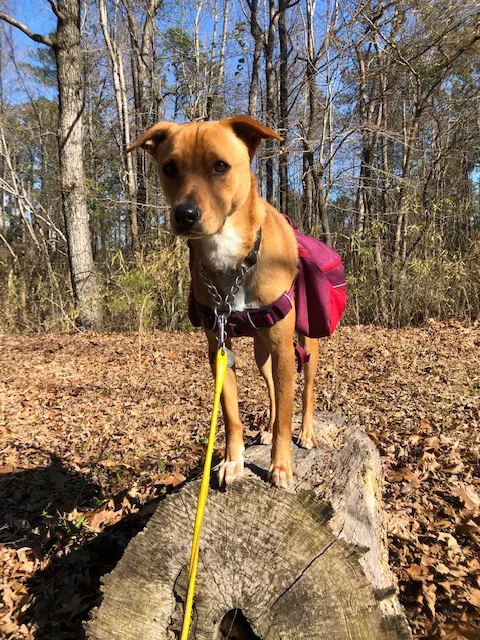My current dog Wally is a 40 lb, 1.5 year young Feist mix who keeps me on my toes! This post is all about how to keep an active dog busy!
The Feist breed is a working dog who was bred to hunt squirrels. Wally would definitely come up with ways to entertain himself if I didn’t channel his energy in a way that works for me without annoying me or stressing me out!
I use a number of different ways to keep my active dog busy, entertained and exercised on a daily basis.
I keep my active dog busy by exposing him to the following:
- Boundaries
- Physical and mental exercise
- Chewing
- Playtime
- Downtime
In addition to that, I also ensure my active dog gets some socialization in public at least once per week.
How to keep an active dog busy
A typical day in Wally’s current life looks something like this:
- 6 am: Morning potty break in yard
- 6:30-7:15 am.: Morning backpack walk (usually with a doggie friend)
- 7:30 am: Breakfast
- Lounging outside or inside, depending on weather
- 8:30 am: Potty break in yard with playtime and nose games, some training
- Noon: 30 min walk, followed by playtime and edible chew
- Lounging inside
- 4 pm: Potty break in yard with playtime, nose games, some training
- 5 pm: Dinner
- Lounging inside or outside, along with playtime, depending on weather
- 8-8:15 pm: Nose games on stairs
- 8:45-9:15 pm: Evening backpack walk (usually with a doggie friend)
- Lounging inside or outside, depending on weather
- 10 pm: Last potty break in yard
- Bed time, right after last potty break
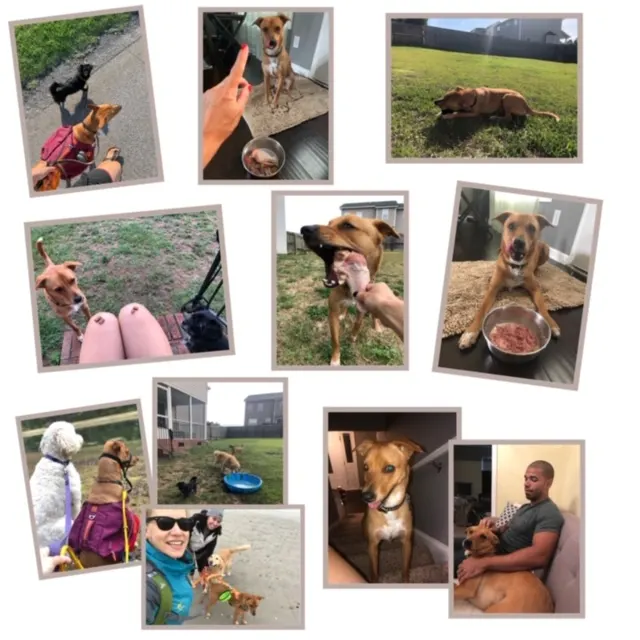
Setting boundaries with an active dog
Let me start by talking about boundaries. I believe they’re the foundation, or frame work of sorts, of a well behaved, polite dog.
The most important rules I’ve established with Wally so far are:
- Boundaries around food
- Self-control inside my or any home around furniture
- Boundaries on walks and inside dog-friendly establishments
- Self-control when greeting people and other dogs
Boundaries around food
One of the first boundaries I set for Wally was polite behavior around food. Breakfast and dinner now include 20-30 seconds of waiting and making eye contact with me before he’s allowed to eat his raw meals. He also learned to accept my hand inside his bowl. I simply taught him that concept by feeding him out of my hand a few times, and he was very receptive of it.
Rules with dogs and furniture
Polite behavior around and on my furniture is equally important to me, as well as behaving politely in other people’s homes. He learned not to bounce around on, play or eat edible chews on it when he first came to live with me at the beginning of this year.
Initially, that’s exactly what he felt like doing, including marking on the back of my favorite midcentury sectional couch!
Now that was a BIG no-no that I fixed within just a few days by making him wear a doggie diaper inside since I had one handy. I had never had to deal with this type of misbehavior, and the only reason why the diaper solution more or less immediately popped into my brain is because some of my pet sitting clients have elderly dogs with weak bladders who wear diapers or belly bands.
Doggy diapers to stop marking
You may wonder why I had a doggie diaper more or less within reach?
I had a few left over from my late Boxer Missy’s heat cycle that occurred AFTER her initial spay. It turned out she had an additional half ovary that was missed during the first surgery, and since it was active enough to cause her to bleed, she ended up having to have a second spay in order to remove that half ovary.
But back to Wally. He truly didn’t have the best manners, and being stressed out by moving around from one home to the next didn’t help his cause.
So along with having him wear the diaper, I started by teaching him a basic sit, followed by stay. Until he had those commands down to a certain degree, I kept him on a multifunctional leash that I looped around a furniture leg or my fridge door, depending on where I was inside the house. When I had to leave for work, I’d crate him. 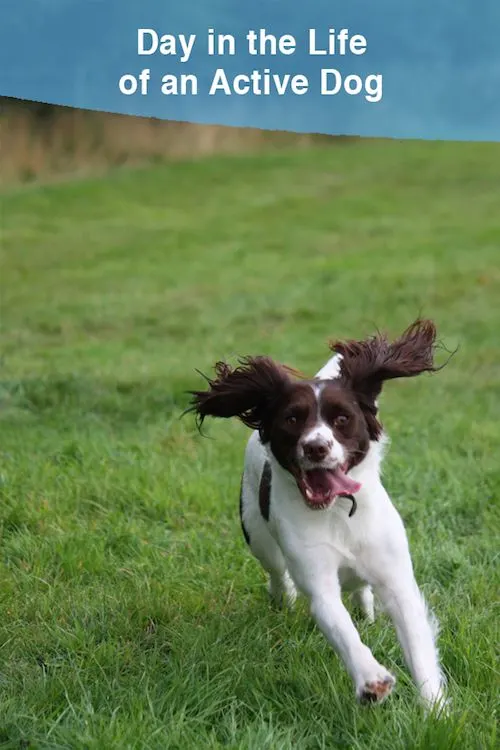
That combination turned him from a confused, unconfident dog who acted out into a much better behaved young dog in a matter of just a few weeks.
He currently no longer needs a diaper, and he also no longer requires to be crated when he’s home alone. The physical and mental exercise I expose him to on a daily basis ensures that he’s calm and relaxed when I have to leave the house. We’ve also made a ton of progress out on walks and inside stores that allow dogs, but we still have to fine tune a few things.
Physical & Mental Exercise for Active Dogs
As far as exercise is concerned, Wally is now familiar with the following activities:
- Backpack walks
- Nose games inside on stairs
- Nose games outside in backyard
- Practicing obedience
- Learning new tricks
Wally jumps out of bed the SECOND my alarm goes off and is ready to seize the day, which is why it’s so important to channel all of that energy into something productive! I let him out into my backyard for a first potty relief, and then he knows to stand by the front door, ready to have his backpack strapped onto him for a 30-45 minute morning walk.
Walking a dog with a backpack
As I outlined above, we begin and end our days with backpack walks. Doggie backpack walks, that is.
Let me elaborate a little on the doggie backpack. It’s a wonderful tool for adding a more intense element of exercise because it has both a physical and a mental component.
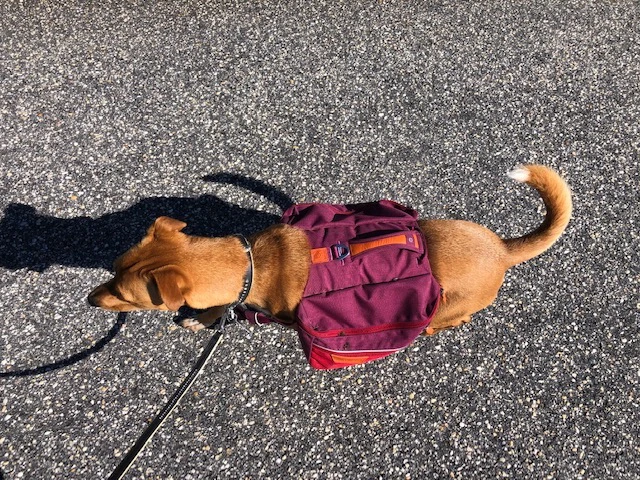
The weight of the pack is the physical component, and the job of carrying the pack is the mental component. Combined, the two increase the intensity of any walk or hike, making the doggie backpack great for higher energy dogs. See our post: Backpacks for dogs.
There are a variety of brands who sell doggie backpacks, and I’ve tested several different ones over the course of the last 6 years. I will say that I’ve only been truly impressed by Ruffwear’s backpacks because of their quality and smart design (attached to a harness).
Wally’s current backpack is the Ruffwear Commuter Pack. It has one small and one large pocket on each side that have zipper closures. I fill them with poop bags, toys, and … currently cans of jellied cranberry that I had leftover from last year’s Thanksgiving dinner preparations. Whatever works to add weight, right?!
Training on walks
On our walks, I’m not overly concerned about having him in a perfect heeling position at all times, but I don’t allow leash pulling and expect him to check in with me, i.e. look up to me for guidance, several times throughout our walks.
I’d start teaching him that by changing directions frequently and rewarding him for following me with tasty training treats. I still give him treats every now and then, but don’t always carry them along on our walks because I want him to pay attention to me even when I don’t have treats on me.
While walks are an important cornerstone of Wally’s days, I’ll admit that there are those days when:
a) I truly don’t have the time to walk him because I’m so busy exercising all of my client dogs (I know, it’s kind of funny when the dog walker doesn’t have the time to walk her own dog)
b) I don’t have the energy or feel like going for an early morning walk
Sometimes there are days when I don’t feel like going for an afternoon or evening walk either. *GASP* The tricky part on those days is that Wally still feels the need to go explore the outdoors in order to deplete himself of his energy. I’ve learned to come up with strategies to cope with his needy doggie butt on those occasions.
Hiring a dog walker and other tips
My support system consists of:
- a dog walker and/or
- a tasty, long lasting chew (see Chewing section below)
- as well as small training treats and stairs/yard (nose work)
I’m super lucky in having found a very reliable dog walker/pet sitter who only lives a few houses down the street from us. She’s helped me out on several occasions over the last few months, and sometimes brings her kids along on walks or for playtime, which I love because it teaches Wally to be gentle around them.
Mental exercise for active dogs
As far as mental exercise is concerned, I encourage Wally to think on several occasions throughout the day. That activity drains him of his mental energy and leaves him calmer.
Now how do I get him to think? By asking him to:
- respect the boundaries I set inside the house
- sniff out treats during our nose work games
- accept carrying his backpack, and
- working on obedience commands and tricks, such as the shake command
Spoiler alert: We’re currently working on the playing dead command.
The nose work games I expose him to also help in draining him of his mental energy since they require him to use his nose and sniff the treats out that I throw out into the backyard.
We do the same inside, and usually start on stairs. We’ll both sit at the top of the stairs and I’ll throw a small treat down the stairs, which he is extremely eager to run after and eat.
We just recently started adding the stay command to make this particular exercise a little more demanding. He now has to wait for my ok release before he can run downstairs.
It’s a wonderful way of tiring him out both physically and mentally, and the chondroitin and glucosamine he absorbs from eating his raw meaty bones keep his joints well lubricated for this type of activity.
Chewing for active dogs
As I just mentioned, raw meaty bones are a great source of chondroitin and glucosamine, and they’re part of Wally’s chewing supply, along with recreational chews and chew toys.
I encourage chewing because it has the following benefits:
- Cleans teeth
- Relieves boredom
- Exercises jaws
Tip: It also soothes pain in teething puppies.
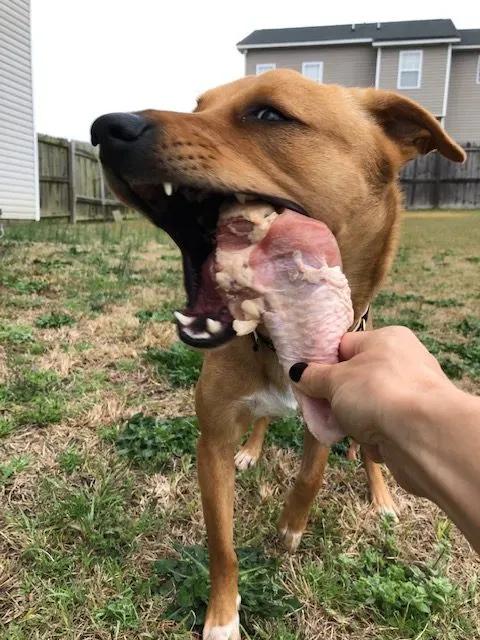
Wally eats raw meaty bones as part of his raw diet. He loves to go to town on duck necks, turkey necks, and chicken thighs and leg quarters. He also has his very own toy box with a variety of squeaky toys and chew toys that he has access to 24/7. But he only gets edible chews when I or someone else can actively supervise him.
I usually toss him a hollow Kong toy that I fill with some sort of treats or his raw food when I need to entertain him for a while without having the time to actively engage with him. Freezing it overnight makes it last even longer.
How to keep an active dog busy with playtime
Wally is a goof at heart and loves a good playtime session, whether it’s with me, another human or dog, or just himself and a toy.
As mentioned in the previous section on chewing, he has his own toy box and helps himself to it throughout the day. But I also actively engage him in playtime a few times per day. Sometimes we play in the backyard, and at other times I’ll join him in the living room or my bedroom, play bowing and all 😉
His favorite toy that comes out right before bedtime is this really long, plush squeaky snake. See our post: Most durable dog toys.
Wally has the best time tossing it around and getting it to squeak. He usually plays with it for 10-15 minutes while I take care of my nighttime routine in the bathroom, and then he’ll drop it when I climb into bed and tucks himself in.
I’m really proud of no longer having to wrestle it out of his mouth because one of the biggest challenges I had with Wally when he first came into my life was his toy possessiveness and unwillingness of letting go of plush toys.
I mentioned in a previous post I wrote for That Mutt how he’d literally kidnap plush toys from pet retail stores, meaning I had to pay for them. As in he’d be standing next to me at the checkout counter, toy in his mouth, waiting to leave the store with it. I couldn’t believe it!
Downtime for active dogs
At the end of a long, impression-filled day, every dog needs quality downtime, and Wally is no exception.
As you can tell from our daily schedule in the opening paragraph, he gets about 8 hours of sleep every night. This is plenty of time to replenish his energy levels. That’s why he’s ready to press the repeat button on his daily routine as soon as he wakes up the next morning!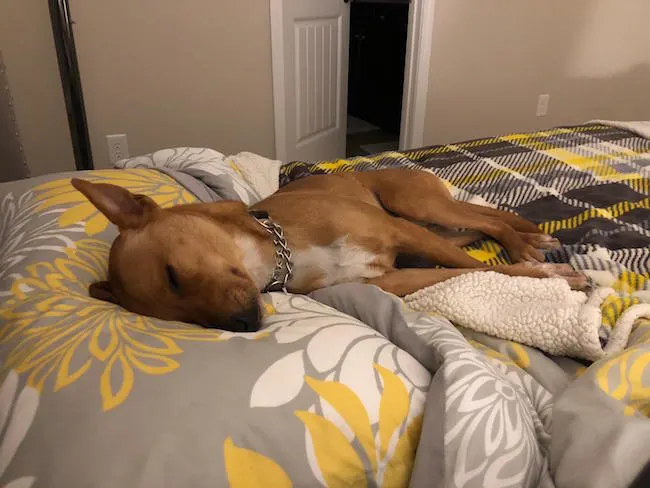
Besides his nighttime sleep, I also ensure that Wally gets a decent amount of quality downtime between our exercise sessions. That translates into several calm spaces throughout the house that he feels comfortable curling up or stretching out in.
He does have a round doggie bed that I got for him on Amazon, but he’s not overly crazy about using it…so rather than buying a new bed, I’m sharing my furniture with him since he does enjoy lounging on it.
What he ends up doing is lounging on several different couches parts of which I lined with doggie blankets. He also has a dedicated spot on my bed that’s covered with a doggie blanket. He knows I expect him to stay on the blanketed part, and is actually really good about staying there.
What does your dog’s day look like? Let us know in the comment section!
Barbara Rivers writes regularly for That Mutt. She is a blogger, raw feeder and dog walker and maintains the blog K9s Over Coffee.
Related posts:

